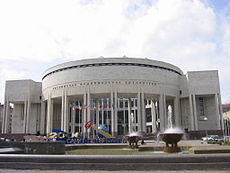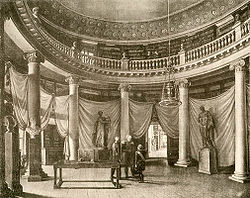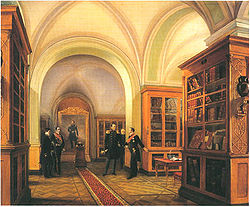- National Library of Russia
-
Российская национальная библиотека English The National Library of Russia 
New building of the Library Country Russia Type National library Established 1795 Reference to legal mandate Decree of the Government of the Russian Federation authorizing the Statute of the Federal State Institution "The National Library of Russia" (March 23, 2001) Location St Petersburg Coordinates 59°56′0.66″N 30°20′8.28″E / 59.9335167°N 30.3356333°E Collection Items collected Books, journals, newspapers, magazines, official publications, printed music, sound and music recordings, databases, maps, stamps, prints, drawings, manuscripts and media. Size 35,718,000 items (15,000,000 books) Criteria for collection Legal deposit of materials published in Russia; "Rossika": materials about Russia or materials published by the people of Russia residing abroad; selected foreign scholarly publications and other materials. Legal deposit Yes (Legal Deposit Law[1]) Access and use Access requirements Reading rooms – free. Russian residents must be 18 or older. Foreign visitors are limited by the period of their visa. Circulation 8,880,000 (2007) Population served 1,150,000 (2007) Other information Budget 569,200,000 RUB ($23,400,000) Staff 1850 Website http://www.nlr.ru/eng/ Phone number +7 812 310-71-37 The National Library of Russia in St Petersburg, known as the State Public Saltykov-Shchedrin Library from 1932 to 1992 (i.e. in the Soviet era), is the oldest public library in Russia. It should not be confused with the Russian State Library, located in Moscow.
Contents
Establishment
The Imperial Public Library was established in 1795 by Catherine the Great, whose private collections included the domestic libraries of Voltaire and Diderot, which she had purchased from their heirs. Voltaire's personal library is still one of the highlights of the collection.
The cornerstone of the public library came from the Polish-Lithuanian Commonwealth in the form of Załuski's Library (420,000 volumes), stolen by the Russians at the time of the partitions.[2] Those books were only partially returned to Poland by the Russian SFSR in 1921 (55,000 printed books).[3]
For five years after its foundation, the library was run by Comte Marie-Gabriel-Florent-Auguste de Choiseul-Gouffier. The elegant main building on Nevsky Prospekt was built in a Neoclassical style designed by the architect Yegor Sokolov in 1796-1801. Several annexes were added in the course of the following century, notably the Gothic Hall in 1857.
19th century
Under Count Alexander Stroganov, who managed the library during the first decade of the 19th century, the Rossica project was inaugurated, a vast collection of foreign books touching on Russia. It was Stroganov who secured for the library some of its most invaluable treasures, namely the Ostromir Gospel, the earliest book written in Russian language, and the Hypatian Codex of the Russian Primary Chronicle.
The Imperial Public Library was officially opened on January 3, 1814 in the presence of Gavrila Derzhavin and Ivan Krylov. In 1811 the library's collection began to grow rapidly, because a copy of each book published in Imperial Russia was henceforth deposited with the library, so that by 1914 the collection had expanded to 3,000,000 volumes.[3]
The library's third, and arguably most famous, director was Aleksey Olenin (1763–1843). His 32-year tenure at the helm, with Sergey Uvarov serving as his deputy, raised the profile of the library among Russian intellectuals. Such luminaries as Krylov, Konstantin Batyushkov, Nikolay Gnedich, Anton Delvig, Mikhail Zagoskin, Alexander Vostokov, and Father Ioakinf joined the library staff and the library's doors were opened to all kinds of readers, including women and peasants.
From 1849 to 1861 the library was managed by Count Modest von Korff (1800–76), who had been Alexander Pushkin's school-fellow at the Lyceum. Korff and his successor, Ivan Delyanov, added to the library's collections some of the earliest manuscripts of the New Testament (the Codex Sinaiticus from the 340s), the Old Testament (the so-called Leningrad Codex), and one of the earlies Qur'ans (the Uthman Qur'an from the mid-7th century).
20th century
In the aftermath of the Russian Revolution, the institution was placed under the management of Ernest Radlov and Nicholas Marr, although its national preeminence was relinquished to the Lenin State Library in Moscow. The library was awarded the Order of the Red Banner of Labour in 1939 and remained open during the gruesome Siege of Leningrad. In 1948, the Neoclassical campus of the Catherine Institute on the Fontanka Embankment (Giacomo Quarenghi, 1804–07) was assigned to the library. By 1970, the Library contained more than 17,000,000 items. The modern building for the book depository was erected on Moskovsky Prospekt in the 1980s and 1990s.
- Highlights of the library
-
Trebizond Gospel (10th cent.)
-
Codex Zographensis (ca. 1000)
-
Leningrad Codex (ca. 1010)
-
Simon Marmion's Grandes Chroniques de France (1450s)
-
Breviary of Mary Stuart (1490s)
References
- ^ Legal Deposit Law
- ^ Малый энциклопедический словарь Брокгауза и Ефрона, published in the Imperial Russia in the early 1900s
- ^ a b Great Soviet Encyclopedia, 3rd. edition
Bibliography
- История Государственной ордена Трудового Красного Знамени Публичной библиотеки имени М. Е. Салтыкова-Щедрина. — Ленинград: Лениздат, 1963. — 435 с., [15] л. ил.
- История Библиотеки в биографиях её директоров, 1795—2005 / Российская национальная библиотека. — Санкт-Петербург, 2006. — 503, [1] с.: ил. — ISBN 5-8192-0263-5.
External links
- Official site of the library
- Russian National Library on the Fontanka Embankment
- Russian National Library on the Moscow Prospect
- The personal library of Voltaire as exhibited in the RNL
National libraries of Europe Sovereign
states- Albania
- Andorra
- Armenia
- Austria
- Azerbaijan
- Belarus
- Belgium
- Bosnia and Herzegovina
- Bulgaria
- Croatia
- Cyprus
- Czech Republic
- Denmark
- Estonia
- Finland
- France
- Georgia
- Germany
- Greece
- Hungary
- Iceland
- Ireland
- Italy
- Kazakhstan
- Latvia
- Liechtenstein
- Lithuania
- Luxembourg
- Macedonia
- Malta
- Moldova
- Monaco
- Montenegro
- Netherlands
- Norway
- Poland
- Portugal
- Romania
- Russia
- San Marino
- Serbia
- Slovakia
- Slovenia
- Spain
- Sweden
- Switzerland
- Turkey
- Ukraine
- United Kingdom
- (England
- Northern Ireland
- Scotland
- Wales)
States with limited
recognition- Abkhazia
- Kosovo
- Nagorno-Karabakh
- Northern Cyprus
- South Ossetia
- Transnistria
Dependencies
and other territories- Åland
- Faroe Islands
- Gibraltar
- Guernsey
- Jan Mayen
- Jersey
- Isle of Man
- Svalbard
Other entities Point of interest in Nevsky Prospekt between Sadovaya Street and the Fontanka River Begin of site Underground foot crossingOdd part
of streetNational Library of Russia · House 37 • Monument to Catherine II in Ekaterininsky Garden at Ostrovsky square · Between house 37 and house 39 • Anichkov Palace buildings and Anichkov Garden · House 39Еven part
of streetState Marionette Theatre, Yevstigney Fomin, Evgeny Demmeny, Priboy Publisying · House 52 • Demidov Hotel, Pauline Viardot, architect Pavel Suzor, Monument to a loud-speaker · House 54 • Karl Bulla's workshop, Monument to the photographer, Karl Bulla · House 54/1 • Sphere Fountain · Malaya Sadovaya Street • Eliseyev Emporium with Akimov's Theatre · House 56 • SPb International commercial bank · House 58 • Aurora cinema, Pyotr Vyazemsky, Dmitri Shostakovich · House 60 • Azov commercial bank · House 62 • World Literature Publishing, Novaya zcizn newspaper · House 64 • Andrei Bely, Andrei Zhelyabov, USSR Union of Writers · House 66End of site Coordinates: 59°56′01″N 30°20′08″E / 59.933516°N 30.335634°E
Categories:- Nevsky Prospekt
- National libraries
- Libraries in Russia
- Public libraries
- Libraries in Saint Petersburg
- Buildings and structures in Saint Petersburg
- 1795 establishments
- Recipients of the Order of the Red Banner of Labour
- World Digital Library
- National Library of Russia collection
- Carlo Rossi buildings and structures
Wikimedia Foundation. 2010.














